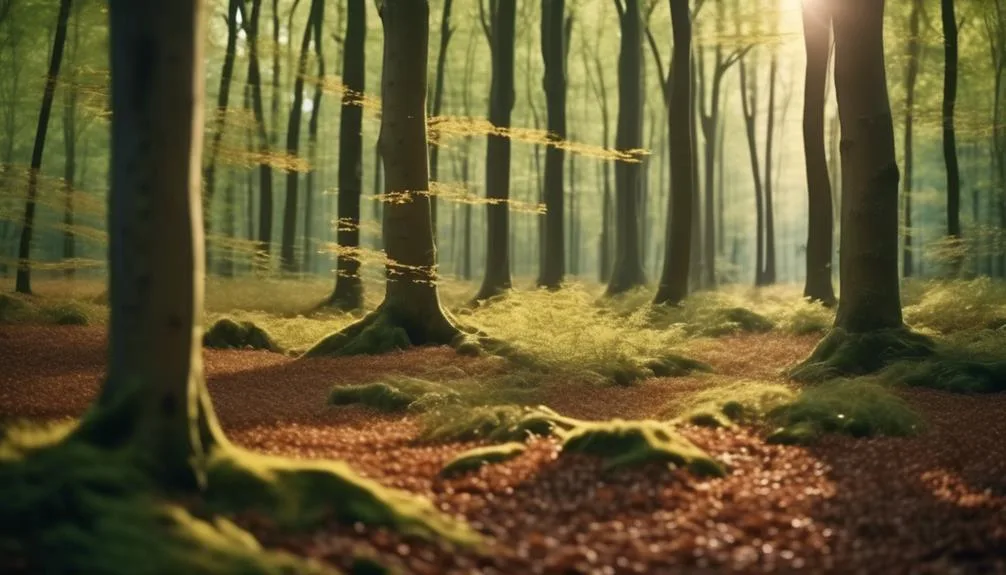Beech trees, known for their beauty, are actually invasive in various parts of the world, causing disruptions and outcompeting native species. From North America to New Zealand, these trees are having a significant impact on the environment.
Why are they considered invasive in these regions, and what effect do they have on the ecosystems? This article will explore the surprising journey of the beech tree and its unexpected role in these regions.
North America
In North America, beech trees have become an invasive species, rapidly spreading and outcompeting native vegetation. Their impact on ecosystems is significant, as they alter the composition and structure of forests, reducing biodiversity and disrupting the balance of native flora and fauna.
Management strategies are essential to control the spread of invasive beech trees. Implementing targeted removal efforts, such as cutting down mature trees and preventing seed production, can help mitigate their negative effects on the environment.
Additionally, promoting the growth of native species through reforestation projects and habitat restoration can aid in restoring the natural balance within affected ecosystems.
It's crucial for land managers and conservationists to work together to develop comprehensive plans for managing invasive beech trees and preserving the health of North American ecosystems.
New Zealand
Thriving in the temperate climate of New Zealand, beech trees have established themselves as a dominant presence in the country's forests, raising concerns about their potential impact on native ecosystems.
- The environmental impact of beech trees in New Zealand includes outcompeting native flora, altering soil composition, and impacting the habitat of native fauna.
- Several management strategies have been implemented to control the spread of beech trees, such as targeted removal in sensitive ecosystems, promotion of alternative native species, and ongoing monitoring to track the extent of their invasion.
- The New Zealand government and conservation organizations are working collaboratively to address the challenges posed by invasive beech trees, aiming to preserve the diversity and ecological balance of the country's unique forests.
Australia
Establishing themselves in the diverse landscapes of Australia, invasive beech trees have raised concerns about their impact on the country's native ecosystems. These trees, particularly the European beech (Fagus sylvatica), have been introduced in parts of Australia for ornamental and forestry purposes. However, their aggressive growth and ability to outcompete native vegetation have led to significant environmental impact, threatening biodiversity and altering ecosystem dynamics.
| Environmental Impact | Management Strategies |
|---|---|
| Displacement of native flora | Manual removal |
| Altered habitat structure | Herbicide application |
| Reduced biodiversity | Monitoring and control |
Efforts to manage the spread of invasive beech trees in Australia include manual removal, herbicide application, and ongoing monitoring and control measures. These strategies aim to mitigate the environmental impact and protect the integrity of Australia's native ecosystems.
South America
Nestled within the diverse landscapes of South America, the presence of invasive beech trees has sparked concern over their potential impact on the region's native ecosystems. These trees, originally from Europe, have been introduced to South America and pose a threat to the region's biodiversity.
- Effects on biodiversity
- Invasive beech trees can outcompete native species for resources, leading to a decline in native plant diversity.
- Their dense foliage can limit sunlight reaching the forest floor, affecting the growth of understory plants and disrupting the balance of the ecosystem.
- The alteration of soil composition by beech trees can further impact the diversity of microbial and fungal communities, affecting nutrient cycling.
To address these challenges, South American countries have implemented management strategies such as monitoring and controlling the spread of invasive beech trees, promoting the restoration of native habitats, and raising awareness about the detrimental effects of these non-native species.
Europe
As you shift your focus to Europe, the impact of invasive beech trees continues to provoke concern over their potential effects on the continent's native ecosystems.
In Europe, beech trees, particularly the North American beech (Fagus grandifolia) and the Oriental beech (Fagus orientalis), have been introduced and have the potential to outcompete native species. Beech tree management in Europe involves efforts to control their spread, as they can form dense stands, reducing light availability for other flora and altering soil nutrient cycling.
The environmental impact of invasive beech trees in Europe extends to the disruption of natural forest dynamics and the potential loss of biodiversity. Conservation efforts in various European countries are focused on monitoring and managing invasive beech populations to mitigate their impact on native ecosystems.
Conclusion
Beech trees' invasive nature poses a significant threat to ecosystems in North America, New Zealand, Australia, South America, and Europe due to their aggressive growth and impact on native species.
Managing their spread remains a crucial challenge, raising concerns about preserving the natural balance in these regions.

My interest in trees started when I first saw the giant sequoias in Yosemite.
I was a teenager then, and I remember thinking, “I need to learn more about this.”
That moment stuck with me.
A few years later, I went on to study forestry at Michigan Tech.
Since graduating, I’ve worked in a mix of hands-on tree care and community education.
I’ve spent over ten years helping people understand how to plant, maintain, and protect the trees in their neighborhoods.
I don’t see trees as just part of the landscape.
They are living things that make a real difference in our daily lives.
